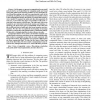Free Online Productivity Tools
i2Speak
i2Symbol
i2OCR
iTex2Img
iWeb2Print
iWeb2Shot
i2Type
iPdf2Split
iPdf2Merge
i2Bopomofo
i2Arabic
i2Style
i2Image
i2PDF
iLatex2Rtf
Sci2ools
114
click to vote
TMM
2002
2002
Computable scenes and structures in films
In this paper, we present a computational scene model and also derive novel algorithms for computing audio and visual scenes and within-scene structures in films. We use constraints derived from film-making rules and from experimental results in the psychology of audition, in our computational scene model. Central to the computational model is the notion of a causal, finite-memory viewer model. We segment the audio and video data separately. In each case, we determine the degree of correlation of the most recent data in the memory with the past. The audio and video scene boundaries are determined using local maxima and minima, respectively. We derive four types of computable scenes that arise due to different kinds of audio and video scene boundary synchronizations. We show how to exploit the local topology of an image sequence in conjunction with statistical tests, to determine dialogs. We also derive a simple algorithm to detect silences in audio. An important feature of our work is ...
Related Content
| Added | 23 Dec 2010 |
| Updated | 23 Dec 2010 |
| Type | Journal |
| Year | 2002 |
| Where | TMM |
| Authors | Hari Sundaram, Shih-Fu Chang |
Comments (0)

